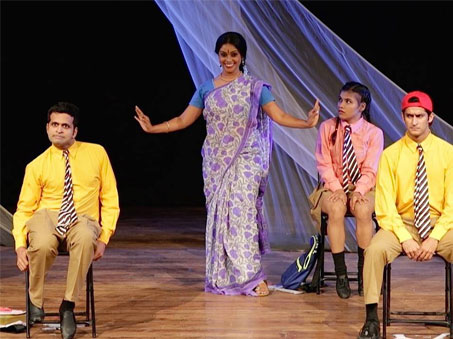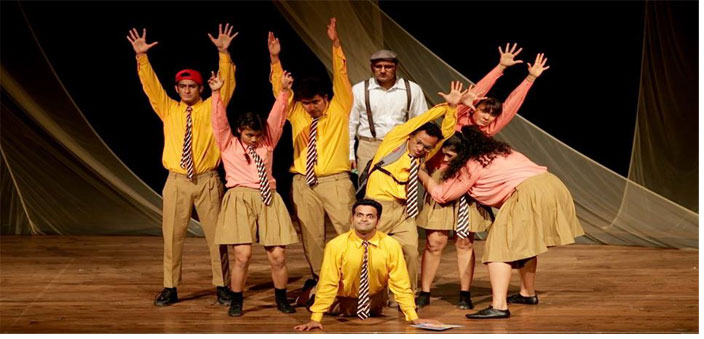Seven students are seated on chairs clustered on the stage. Dressed in khaki pants, shirts, pink for the girls and yellow for the boys, and striped ties, they have their school bags slung on their chairs and books in their hands. Their eyes are fixed on a vague spot above the audience, presumably where a black board would be.
The teacher strides across the length of the stage. “All gerunds are verbal nouns but all verbal nouns are not gerunds,” he drones. The students continue to stare at the ‘blackboard’. As the teacher expounds on gerunds and verbs in a tone that is as straight as the flat line on a heart monitor, the students’ eyes glaze over and droop.
Age-old experiences
The audience titters. In a mixed audience of the very young, the young and the not-so-young, the scene invokes in each one the memory of a boring class and an uninspiring teacher. We often reminsce about our school days, the teachers we loved and those we dreaded, the classmates who topped the class and those who lagged behind. There were teachers’ pets and the mischief-makers, aspiring sport stars and thespian talents, the quiet ones and the popular ones. For many of us, our school days were the best days of our lives. For some, passage of time has lent them a sepia tone, sharpened the happy moments and blurred the sad ones. And then there are those for whom every dawn brought with it the dread for school. Keep Calm and Dance draws our attention to those kids.
The story revolves around the lives of seven classmates and how their insecurities borne out of peer pressure and societal expectations afflict the most impressionable years of their lives. Each ‘kid’ has his own distinct problem. There is Shiv whose suppressed anger causes him to lash out at those closest to him including his mother and best friend Zara. The fashionista Mini obsesses to achieve a size zero figure at the cost of her health. At the other end of the spectrum is Madhuri, nicknamed Hippo by her classmates. She is ridiculed for her size at school and at home nagged by her mother to lose weight. Monty loves to dance but it is not a passion which his father approves of. And there is Roshan who struggles with Math and wishes for someone to explain it to him in a way that would make sense to him. The teachers at school are stuck in their ways, going about the lessons in the same fashion that they have been for years. At home, the parents’ demands for excellence further burdens their drooping shoulders. Add to that the pressure to match the standards accepted by their peers. It seems like nothing could go right for this bunch.

Hope comes to them in the form of a new library teacher, Ms. Chats. She sees their insecurities but also notices the talents that are unique to each one of them. She tells them the story of Yatagarasu, a three-legged mythical Japanese bird whose three legs stand for courage, wisdom and compassion. The story hits home and connects with each of the kids. As the story progresses, the characters uncover their strengths and weaknesses and learn to battle their insecurities. They also recognise the worth of their friends and come to rely on each other for help. As the play heads towards the end, one cannot but help root for these underdogs. Will they overpower their demons? Will they discover that self buried strength deep within? Will they soar like the Yatagarasu?
Music and movement
What stands out through the duration of the play is the innovative use of movement to tell the story. Set to foot-tapping music, a range of dance styles like Hip-hop, Contemporary, Funk, Jazz and Bharatanatyam have been effectively used to create an engaging narrative. Actor-director Yuki Ellias has drawn from her experience of performing in prestigious venues across the globe to keep the audience engaged in the movement-driven narrative of Keep Calm and Dance. Previously she has directed a sci-fi absurd drama, Charge, and also created and performed The Elephant in the Room, a solo act about Ganapati looking for his old boy head.
Writer Nikhil Katara’s first play, The Unveiling which opened at the 2011 Kala Ghoda Arts Festival was a sci-fi drama. With Keep Calm…the writer takes a stab at real-life scenarios and weaves a relatable storyline. Besides writing for the stage, Nikhil also reviews books for the Free Press Journal and facilitates a drama class for young adults at Bombay-based J’s Paradigm. Currently, he is working on his first novel. The play is produced by J Productions, which has been making its presence felt in the performance arena in recent years. Its director and founder Jhelum Gosalia is the founder of a performing arts academy, J’s Paradigm, which strives to create an experience of performing arts for its students. The academy prepares its students for both the Trinity and LAMDA examinations.
Through dance and comedy, Keep Calm and Dance raises some pertinent points about growing-up and the associated pains. It makes us reflect on our school days and identify the Shiv or Zara or Madhuri or Monty among our classmates. And perhaps identify one within us. What make the theme universal is that the nature of the issues that it addresses have remained the same whether one was in a classroom yesterday or thirty years ago. In fact, they go beyond classrooms and schools, and extend into the workspace and social context. What starts with the word ‘Hippo’ or ‘Fatso’ turns into bodyshaming and obsessing over a perceived perfect size manifests into life-threatening food disorders. Bullies from school who remain unchecked find different mediums to continue their bullying ways. Learning disabilities breed low self-esteem which often persists in adult life. Many of the issues we face in school continue to stay with us long after, and infiltrate various realms of our adult lives.
The play does not delve into some more topical challenges like internet bullying, caste and social exclusion, gender and sexual discrimination, etc. But, the timelessness and universality of the issues it raises make the lessons applicable. All mediums of performing arts provide a mirror to the times we live in. The dynamic nature of theatre and the instant chemistry between the creators and the audience elevates its status in context of the social impact it can carry. Effective theatre should not be limited to entertain its audience. It must reside in the heads and hearts of its audience, forcing them to challenge set perceptions and provoke change in their environment. Keep Calm… chooses to deliver its message through song and dance, and therein lies its impact.


 [/column]
[/column]